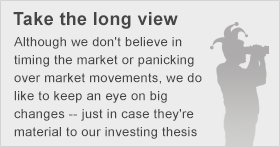
The Federal Reserve Open Market Committee released its statement at 2 p.m today, announcing it was continuing with its taper, as expected, and still expects interest rates to start rising in mid-2015. Immediately, the Dow Jones Industrial Average (DJINDICES: ^DJI) and S&P 500 (SNPINDEX: ^GSPC) jumped on the news, with the highest gains coming from dividend stocks. The Dow finished the day up nearly 100 points, to 16,906. The S&P 500 was up 15 points, to 1,956.
The Federal Reserve's Statement was basically unchanged from April's. The Fed announced that it was cutting its long-term asset purchases from $45 billion a month to $35 billion a month. The one thing the Fed did change was its expectations for growth this year. In line with the World Bank and International Monetary Fund's forecasts the past few weeks, the Fed cut its expectations for growth to 2.1% to 2.3% for the year, but left expectations for 2015 and 2016 unchanged.
With growth slow, but steady, and the Fed keeping interest rates at all-time lows, today's biggest gainers were dividend stocks. The S&P 500 was led higher by the utilities sector, which rose 1.9% on the day, 0.9% higher than any other sector. Also notably, the VIX dropped 7% immediately after the statement, indicating that traders expect there to be little volatility during the coming month.

With the Fed keeping interest rates at all-time lows, savers and yield-hungry investors are paying high prices and taking on more risk to earn little extra reward. Investors taking more risk is what the Federal Reserve has been hoping for, though the Fed was really hoping that investors would invest in the real economy rather than just in the markets. This has not been the case, however, as companies and investors continue to plow money into stocks at high prices rather than investing in productive goods.
In the press conference following the release of the statement, Federal Reserve Chairwoman Janet Yellen warned of "over-complacency" in the markets. While I have argued that the stock market is overvalued, the "over-complacency" that Janet Yellen is worried about can best be seen in the bond market, especially the high-yield corporate bond market. High-yield bonds are those issued by companies with the weakest balance sheets or the weakest businesses. As such, investors demand a higher yield from them to compensate for the risk.
Currently, though, investors aren't asking for much extra yield from high-yield bonds. The high-yield bond market is trading at its lowest spread versus treasuries since 2006, at a spread of just 3.39%.

Investors are taking on extra risk across the market with little reward expected. Source: St. Louis Fed.
Bottom Line
Macro themes don't generally change much from day to day, so I'll end with my usual reminder: Try to stay sober while everyone around you is drunk on Fed-stimulus punch, telling you to join in on the fun. Keep learning, focus on your goals, have an investing plan, stick to it, and ignore the crowds.